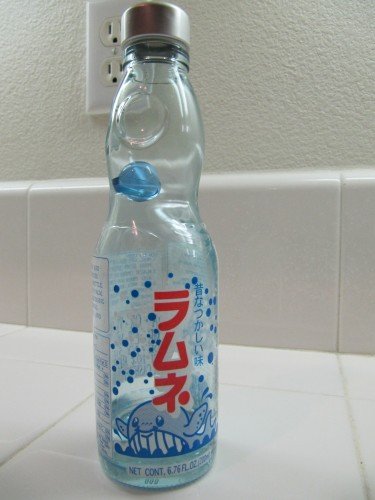Discovering the unique charm of Ramune, Japan’s iconic carbonated drink
I had marble soda for the first time last night and I loved it. So the gimmick is there is a marble inside the soda…get it…marble soda? The marble doesn’t actually come out of the bottle, but as you’re drinking it, you think you’ll swallow it. You can see the blue marble about 3/4 of the way up the bottle in the photo above. What I initially thought was just a novelty drink turned out to be a fascinating piece of beverage history with roots going back to the 19th century!
The Fascinating History of Marble Soda
What I’m drinking is actually a Japanese beverage called “Ramune” (pronounced rah-moo-neh), which has been popular in Japan for over a century. Despite its strong association with Japanese culture, Ramune has international origins. It was introduced in 1884 in Kobe, Japan by a Scottish pharmacist named Alexander Cameron Sim, who based it on lemonade. In fact, the name “Ramune” is derived from the Japanese pronunciation of the English word “lemonade.”
Surprisingly, Ramune was initially marketed as a medicinal drink to prevent cholera. The drink was originally called “mabu soda” (marble soda) in Japanese, referencing its distinctive bottle design. It soon became a hit after being advertised in the Tokyo Mainichi Newspaper, and has since become a beloved part of Japanese summer traditions, particularly during festivals.
Today, Ramune is available in dozens of flavors beyond the original lemon-lime, including strawberry, melon, orange, and some more unusual options like curry or wasabi. However, it’s the unique bottle that remains its most recognizable feature.
The Ingenious Codd-Neck Bottle
The distinctive bottle design wasn’t created in Japan – it’s actually called a “Codd-neck bottle,” invented by British engineer Hiram Codd in 1872. The design features a glass marble and a rubber washer that create an airtight seal to keep the carbonation fresh. Bottles are filled upside down during production, allowing the pressure of the carbonation to push the marble against the rubber washer, creating a perfect seal.
To open the bottle, you use a special plastic plunger (usually included with the drink) to push the marble down into the bottle. Once opened, the distinctive narrowing in the bottle neck prevents the marble from falling to the bottom or blocking the opening while you drink. The marble rattles around inside the bottle as you enjoy your drink, creating a fun, nostalgic experience.
While this type of bottle was once common worldwide for carbonated beverages, Ramune is one of the few drinks that still uses the Codd-neck design. It’s become such an iconic part of the Ramune experience that even Ramune-flavored candies sometimes come in packaging that mimics the marble design.
My Marble Soda Experience
Opening the bottle was half the fun. There’s something uniquely satisfying about pressing the marble down and hearing the “pop” as the carbonation is released. The flavor was refreshing and subtly sweet – the original Ramune flavor is often described as a light citrusy taste similar to lemon-lime soda, but with a distinctive candy-like quality that’s been compared to bubble gum.
The bottle in the photo appears to be the original flavor, which has a light blue hue to match its citrus profile. The text on the bottle is indeed in Japanese (not Chinese as I initially thought), and likely says “Ramune” along with the manufacturer’s branding.
I give marble soda a definite thumbs up! It’s not just the novel bottle design that makes it special, but also the refreshing taste and the cultural experience. Finding Ramune has become easier in recent years – while it was once available only at Asian specialty markets, today it can be found in many large grocery stores in the international section, or online retailers.
A Note on My New Camera
I got my new camera delivered today, and I’m really happy with it so far. I’ll blog more on that later, but this picture was taken with it and as you can see it is going to do a great job for me. The clarity of the image really captures the unique blue hue of the marble and the transparency of the bottle.
A Drink Worth Trying
If you’ve never tried Ramune, I highly recommend seeking it out for the unique experience. It’s more than just a drink – it’s a small piece of cultural history that has maintained its charm for over a century. There’s something wonderfully nostalgic about the sound of the marble rolling around inside the bottle as you enjoy the refreshing beverage.
Have you tried marble soda before? What was your experience like? Did you manage to figure out how to open it without making a mess? Let me know in the comments!
Join the Conversation
Have you tried unusual beverages from other countries? What’s the most interesting drink packaging you’ve encountered? Share your experiences in the comments below!

Amy says:
It’s Japanese. It’s called Ramune (RAW-moo-nay). It really has nothing to do with Pepsi, and will often come with Hello Kitty on the front, like so many things in Japan.
mijbil says:
this is 7 down